Research on the Rheological Characteristics and Aging Resistance of Asphalt Modified with Tourmaline
Abstract
1. Introduction
2. Raw Materials and Preparation Process
2.1. Raw Materials
2.2. Preparation Process of TMA
2.3. Storage Stability Test
2.4. Dynamic Mechanical Analysis
2.5. Bending Beam Rheometer (BBR) Test
2.6. Aging Procedures
2.7. Scanning Electron Microscopy (SEM) Test
3. Results and Discussion
3.1. Storage Stability of TMA
3.2. Rheological Properties of TMA at High Temperature
3.3. Rheological Characters of TMA at Low Temperature
3.4. Aging Resistance of TMA
3.5. Result of SEM
4. Conclusions
- (1)
- The storage stability of TMA binder was capable significantly improved by the smaller particle size and negative ions treated surface of the tourmaline modifier.
- (2)
- The complex modulus () and of asphalt binder were increased by the tourmaline modifier, which indicated the enhancement of the strength and rutting resistance for asphalt binders. The decrease of phase angle for modified asphalt binder reveals the increase of elastic components in viscoelastic characters of asphalt binder.
- (3)
- The ZSV values of TMA binder were increased and the elastic recovery capacity and the properties of asphalt are used to resist rutting are enhanced by the tourmaline modifier.
- (4)
- The low temperature rheological characters of modified asphalt is also can be deteriorated by the tourmaline to some extent. However, modifier with a smaller particle size and negative ion treated surfaces show better influences.
- (5)
- The rheological properties of asphalt binder were improved by the tourmaline modifier, either after RTOFT or PAV. The asphalt binder modified with the smaller particle size of tourmaline has better aging resistance.
- (6)
- The light oil and saturated portion of the asphalt can be absorbed by the tourmaline modifier. A thicker interfacial layer can be formed between tourmaline and asphalt, which results in the enhanced properties that can be used to resist permanent deformation.
Author Contributions
Funding
Conflicts of Interest
References
- Rodríguez-Alloza, A.M.; Gallego, J.; Giuliani, F. Complex shear modulus and phase angle of crumb rubber modified binders containing organic warm mix asphalt additives. Mater. Struct. 2017, 50, 77–81. [Google Scholar] [CrossRef]
- Xiao, F.P.; Hou, X.; Amirkhanian, S.; Kim, K.W. Superpave evaluation of higher RAP contents using WMA technologies. Constr. Build. Mater. 2016, 112, 1080–1087. [Google Scholar] [CrossRef]
- Romier, A.; Audeon, M.; David, J.; Martineau, Y.; Olard, F. Low-energy asphalt with performance of hot-mix asphalt. Transp. Res. Rec. 2006, 1962, 101–112. [Google Scholar] [CrossRef]
- Chavez-Valencia, L.; Alonso, E.; Manzano, A.; Pérez, J.; Contreras, M.; Signoret, C. Improving the compressive strengths of cold-mix asphalt using asphalt emulsion modified by polyvinyl acetate. Constr. Build. Mater. 2007, 21, 583–589. [Google Scholar] [CrossRef]
- Lv, S.T.; Liu, C.C.; Yao, H.; Zheng, J.L. Comparisons of synchronous measurement methods on various moduli of asphalt mixtures. Constr. Build. Mater. 2018, 158, 1035–1045. [Google Scholar] [CrossRef]
- Tang, N.; Deng, Z.; Dai, J.G.; Yang, K.; Chen, C.; Wang, Q. Geopolymer as an additive of warm mix asphalt: Preparation and properties. J. Clean. Prod. 2018, 192, 906–915. [Google Scholar] [CrossRef]
- Hu, J.; Wanasekara, N.; Yu, X. Thermal properties of thermochromic asphalt binders by modulated differential scanning calorimetry. Transp. Res. Rec. 2014, 2444, 142–150. [Google Scholar] [CrossRef]
- Jin, J.; Tan, Y.Q.; Liu, R.H.; Zheng, J.L.; Zhang, J.H. Synergy Effect of Attapulgite, Rubber, and Diatomite on Organic Montmorillonite-Modified Asphalt. Mater. Civ. Eng. 2019, 31, 04018388. [Google Scholar] [CrossRef]
- Zhang, H.L.; Gao, Y.; Guo, G.H. Effects of ZnO particle size on properties of asphalt and asphalt mixture. Constr. Build. Mater. 2018, 159, 578–586. [Google Scholar] [CrossRef]
- Xiao, Y.; Wan, M.; Jenkins, K.J.; Wu, S.P.; Cui, P.Q. Using activated carbon to reduce the volatile organic compounds from bituminous materials. Mater. Civ. Eng. 2017, 29, 04017166. [Google Scholar] [CrossRef]
- Qin, X.; Shen, A.; Guo, Y.; Li, Z.; Lv, Z. Characterization of asphalt mastics reinforced with basalt fibers. Constr. Build. Mater. 2018, 159, 508–516. [Google Scholar] [CrossRef]
- Yao, D.S. Tourmaline-A New Material about Environment and Health; Textile & Apparel Press: Shanghai, China, 2001. [Google Scholar]
- Li, F.F. Property of tourmaline and application prospect. ExpressInf. Min. Ind. 2007, 3, 10–12. [Google Scholar]
- Dietrich, R.V. The Tourmaline Group; Van Nostrand Reinhold Company: New York, NY, USA, 1985. [Google Scholar]
- Ertl, A.; Hughes, J.M.; Marler, B. Empirical formulae for the calculation of <T–O> and X–O2 bond lengths in tourmaline and relations to tetrahedrally coordinated boron. Neues Jahrb. Mineral. Mon. 2001, 12, 548–557. [Google Scholar]
- Huang, Y.L.; Zheng, S.L.; Li, Y. The machine application and prospect of tourmaline. J. China Non-Met. Min. Ind. Her. 2003, 4, 18–21. [Google Scholar]
- Lin, S.G.; Cai, K.Q.; Cai, X.H. The new progress of tourmaline study. J. China Non-Met. Min. Ind. Her. 2005, 1, 20–23. [Google Scholar]
- Zhang, Z.X.; Feng, A.S.; Guo, Z.X. Permanent spontaneous polarization of tourmaline and its application to environment and health field. J. China Non-Met. Min. Ind. Her. 2003, 1, 47–49. [Google Scholar]
- Hu, J.; Yu, X.B. Preliminary Evaluation of Thermal Performance of Asphalt Concrete Pavement: Influence of Thermochromic Materials. In Proceedings of the Transporation Research Board. 94th Annual Meeting, Washington, DC, USA, 11–15 January 2015. [Google Scholar]
- Hassan, M.; Mohammad, L.; Cooper, S., III; Dylla, H. Evaluation of nano-titanium dioxide additive on asphalt binder aging properties. Transp. Res. Rec. 2011, 2207, 11–15. [Google Scholar] [CrossRef]
- Mohammad, L.; Hassan, M.; Cooper, S. Mechanical characteristics of asphaltic mixtures containing titanium-dioxide photocatalyst. J. Test. Eval. 2012, 40, 1–8. [Google Scholar] [CrossRef]
- Zhang, H.; Chen, Z.; Li, L. Effect of nanozinc oxide and organic expanded vermiculite compound on antiaging properties of SBR modified bitumen. Mater. Civ. Eng. 2017, 29, 04017204. [Google Scholar] [CrossRef]
- Wang, C.H.; Wang, P.; Li, Y.W.; Zhao, Y. Laboratory investigation of dynamic rheological properties of tourmaline modified bitumen. Constr. Build. Mater. 2015, 80, 195–199. [Google Scholar] [CrossRef]
- Wang, C.H.; Li, Y.W.; Sun, X.L.; Gao, Z.W. Automobile exhauste purifying performance of tourmaline-modified asphalt concrete. Mater. Civ. Eng. 2017, 29, 04017004. [Google Scholar] [CrossRef]
- Wang, C.H.; Li, Y.W.; Sun, X.L.; Gao, Z.W. Pavement performance of tourmaline modified asphalt mixture. J. Changan Univ. 2014, 34, 1–8. [Google Scholar]
- Wu, C.H.; Li, Y.W.; Lu, Y.; Yang, L.; Du, Q.; Hu, S. Pavement cooling performance of tourmaline modified asphalt concrete. Funct. Mater. 2014, 45, 11081–11086. [Google Scholar]
- Wang, X.Q.; Dong, B.; Wang, C.H.; Wang, X.H. Research on Proportioning Design of Tourmaline Modified Asphalt Mixture. Appl. Mech. Mater. 2013, 405–408, 1928–1931. [Google Scholar] [CrossRef]
- Hu, S.M.; Wang, C.H.; Du, Q.L.; Li, R. Research on Aging Properties of Tourmaline Modified Asphalt. In Advanced Materials Research; Trans Tech Publications: Stafa-Zurich, Switzerland, 2012; Volume 535–537, pp. 1715–1718. [Google Scholar]
- Hu, Y.M.; Li, Y.H.; Li, M.C.; Lv, G.; Liu, Q.; Hou, C. The preparation and characterization of tourmaline-containing functional copolymer p (VST/MMA/BA). J. Spectrosc. 2018, 5, 1–7. [Google Scholar] [CrossRef]
- Çelikbilek, Y.; Tüysüz, F. An integrated grey based multi-criteria decision making approach for the evaluation of renewable energy sources. Energy 2016, 115, 1246–1258. [Google Scholar] [CrossRef]
- AASHTO T 240. Standard Method of Test for Effect of Heat and Air on a Moving Film of Asphalt Binder (Rolling Thin-Film Oven Test); American Association of State Highway and Transportation Officials: Washington, DC, USA, 2015. [Google Scholar]
- AASHTO R 28. Standard Practice for Accelerated Aging of Asphalt Binder Using a Pressurized Aging Vessel (PAV); American Association of State Highway and Transportation Officials: Washington, DC, USA, 2015. [Google Scholar]
- Chen, Q.; Wang, C.H.; Wen, P.H.; Sun, X.L.; Guo, T.T. Performance evaluation of tourmaline modified asphalt mixture based on grey target decision method. Constr. Build. Mater. 2019, 205, 137–147. [Google Scholar] [CrossRef]
- Ding, H.B.; Rahman, A.; Li, Q.S.; Qiu, Y.J. Advanced mechanical characterization of asphalt mastics containing tourmaline modifier. Constr. Build. Mater. 2017, 150, 520–528. [Google Scholar] [CrossRef]
- Chen, Q.; Wang, C.H.; Wen, P.H.; Wang, M.H.; Zhao, J.X. Comprehensive performance evaluation of low-carbon modified asphalt based on efficacy coefficient method. J. Clean. Prod. 2018, 203, 633–644. [Google Scholar] [CrossRef]
- Gawel, I.; Czechowski, F.; Kosno, J. An environmental friendly anti-ageing additive to bitumen. Constr. Build. Mater. 2016, 110, 42–47. [Google Scholar] [CrossRef]

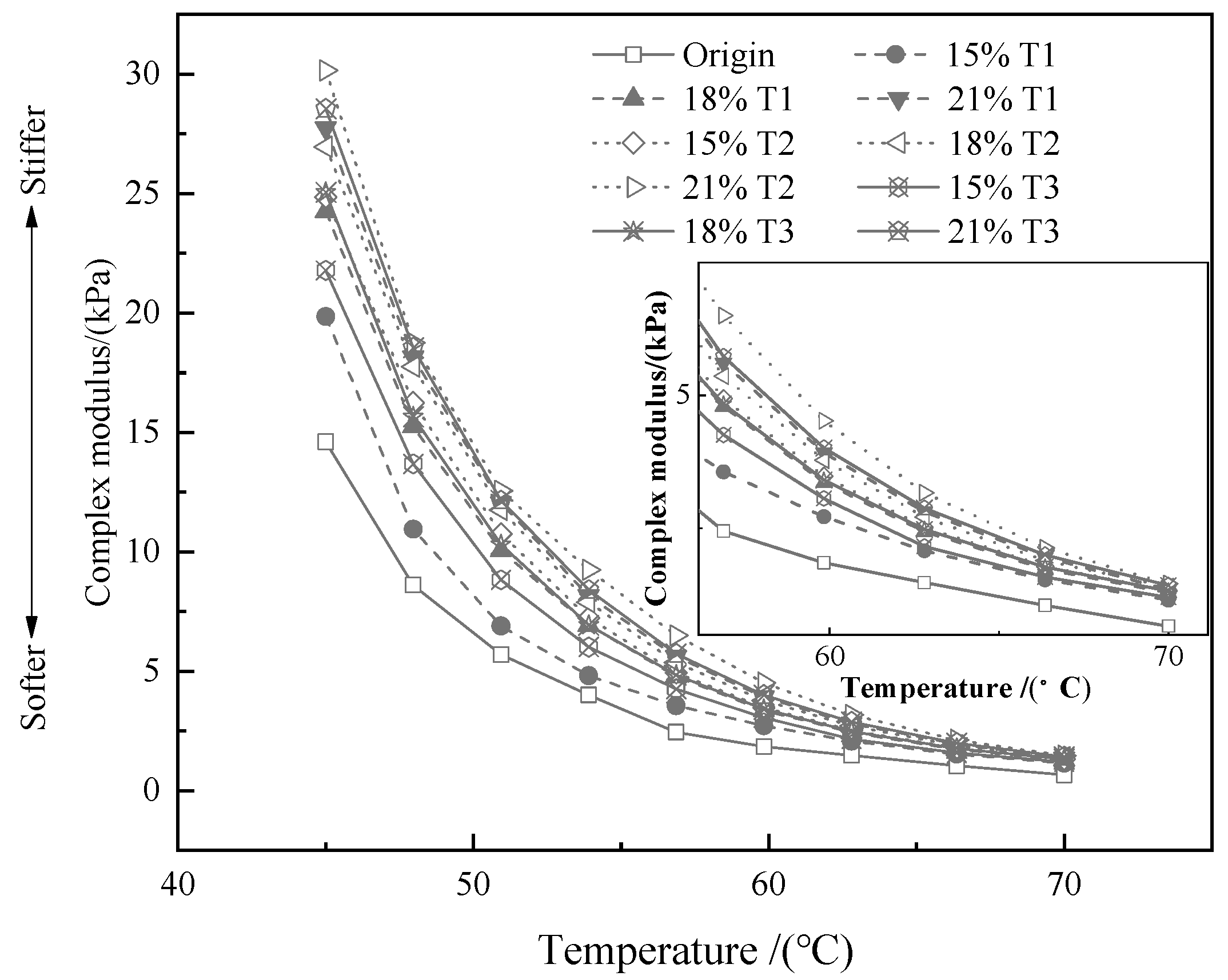
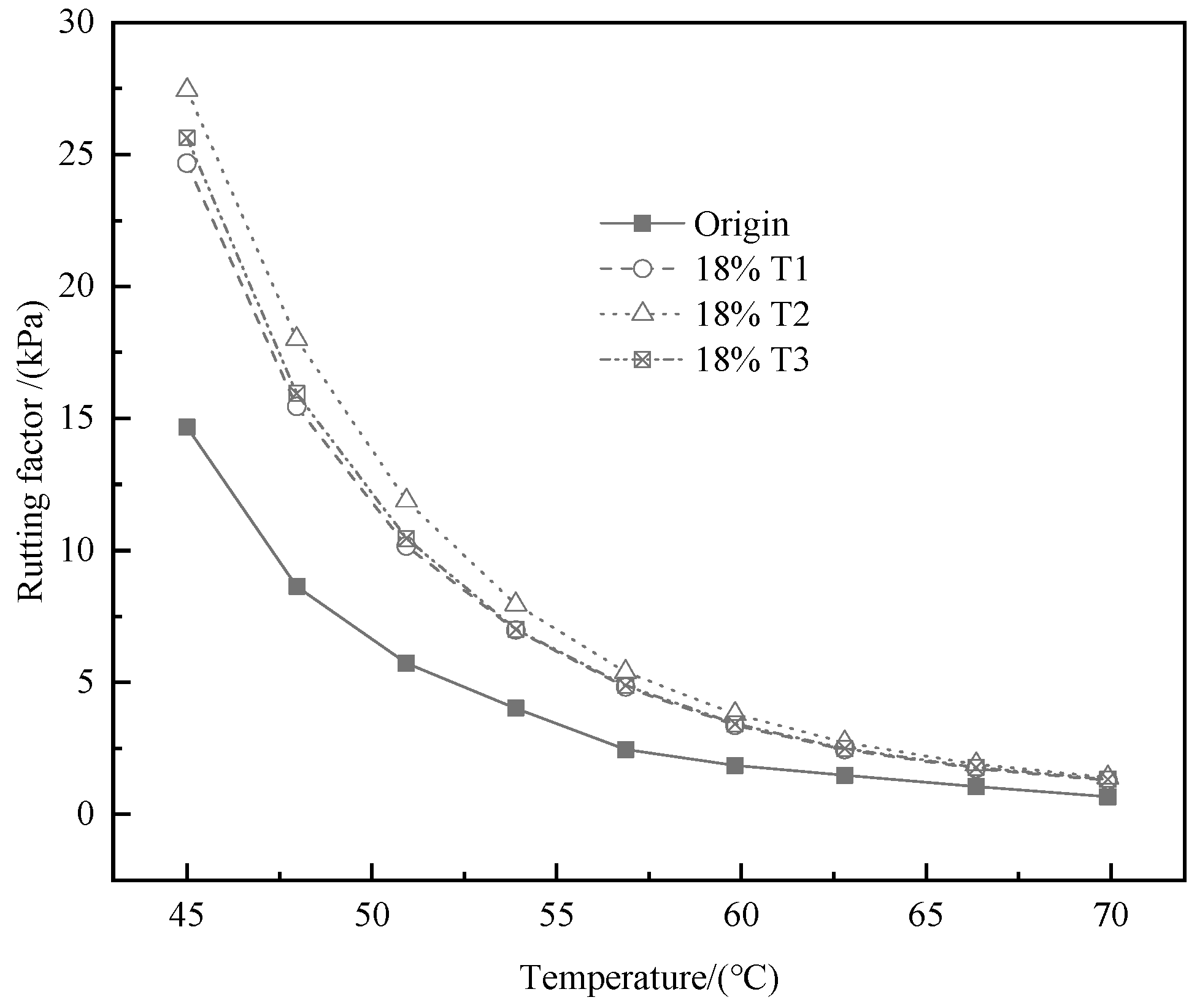

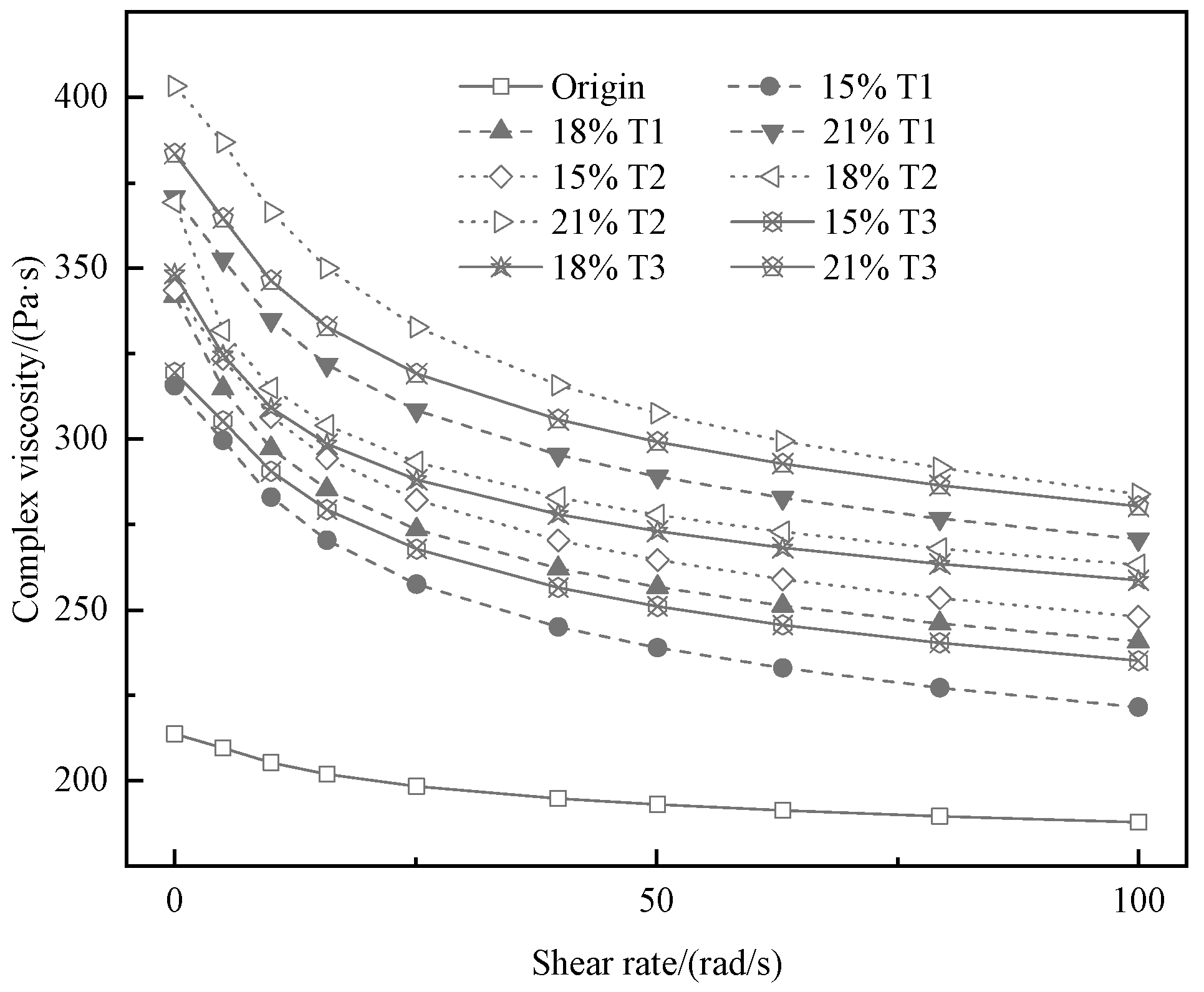
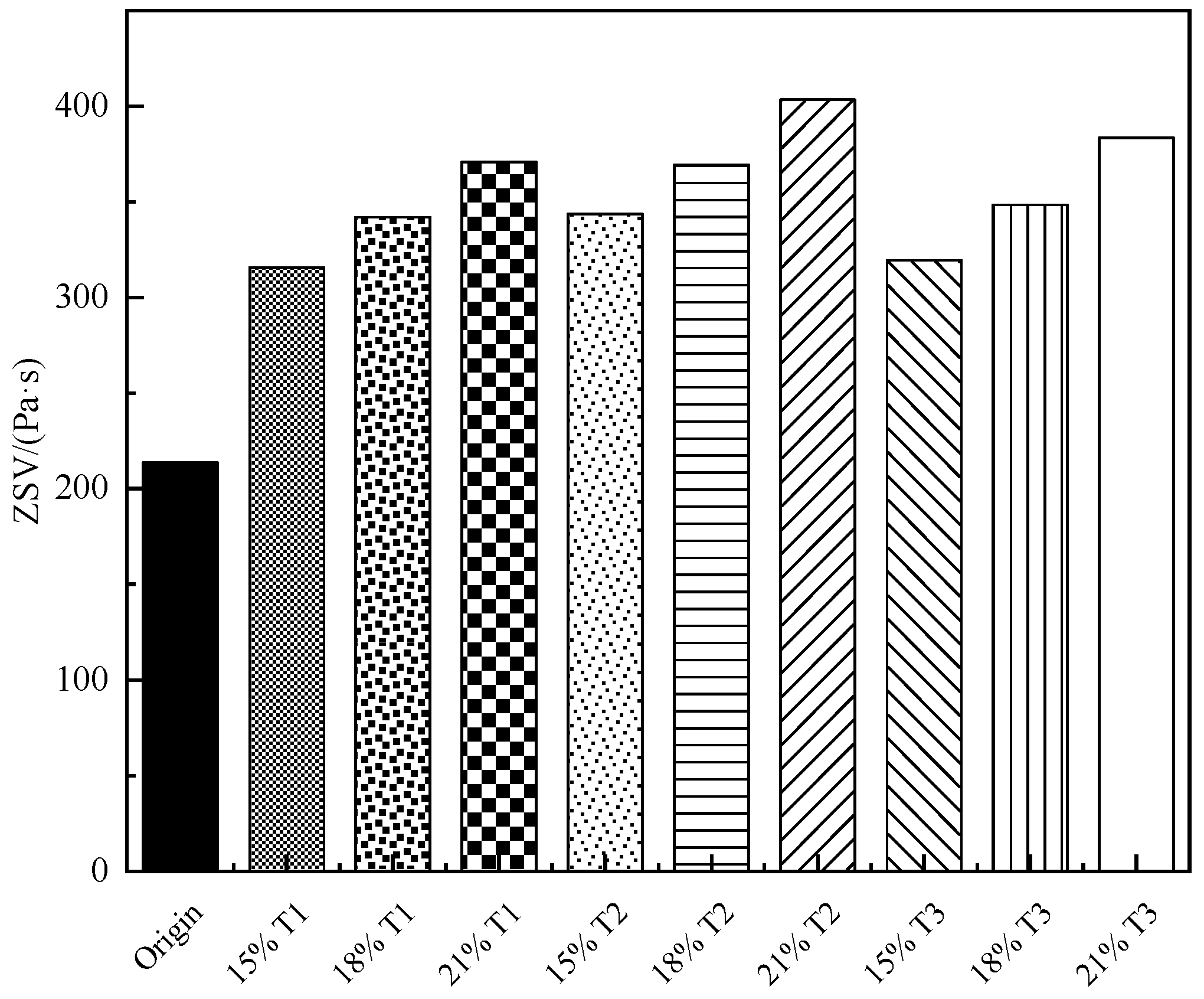

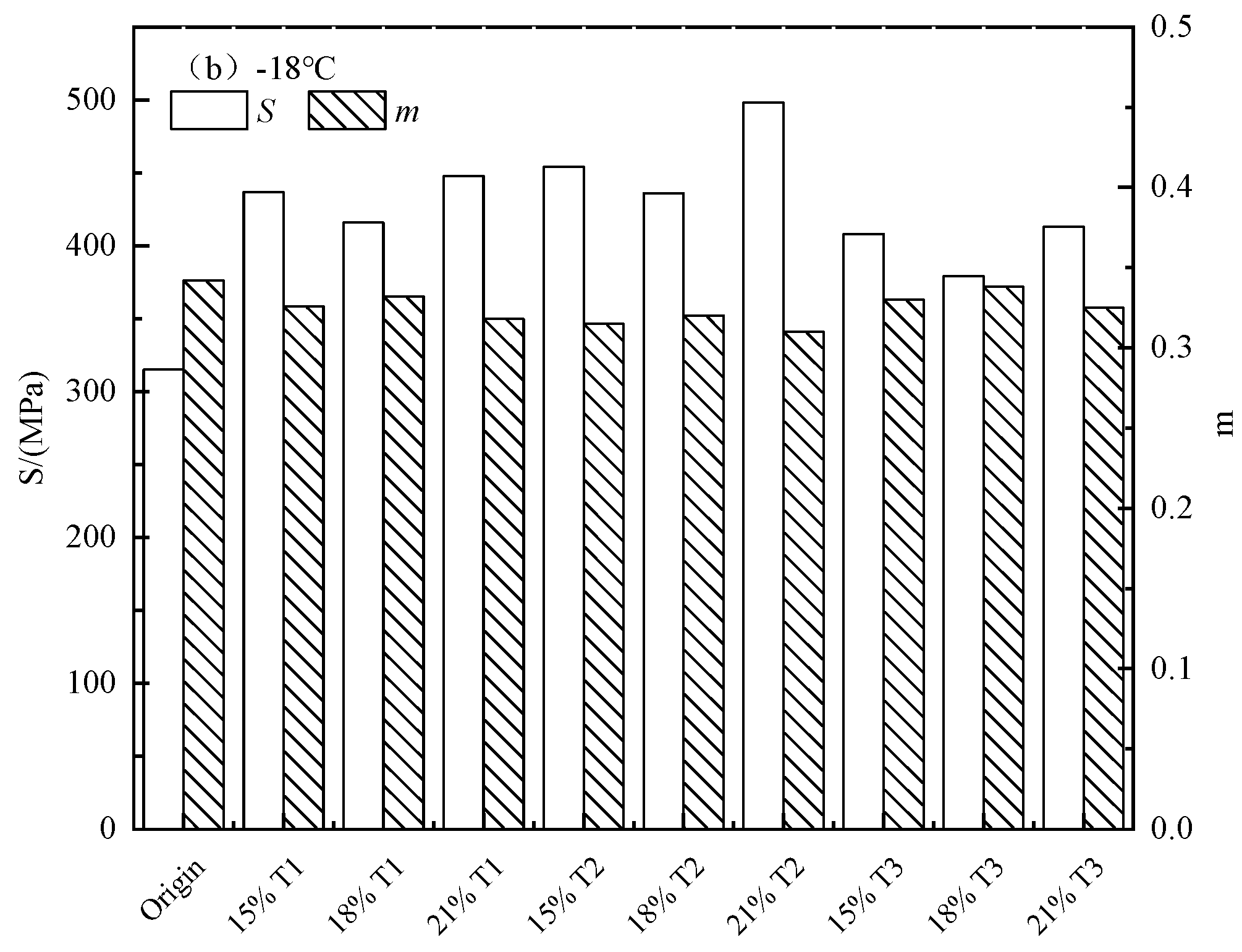



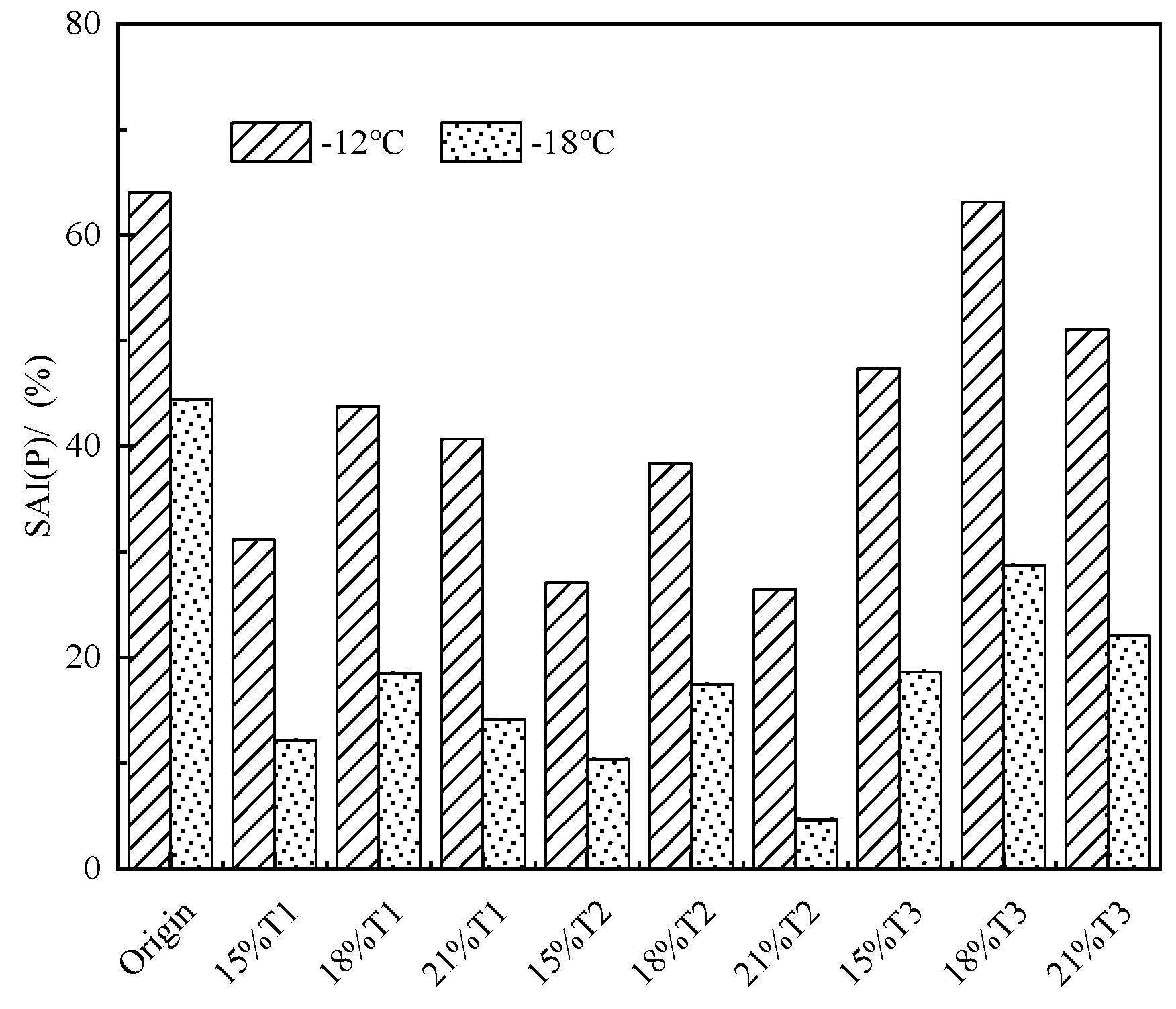
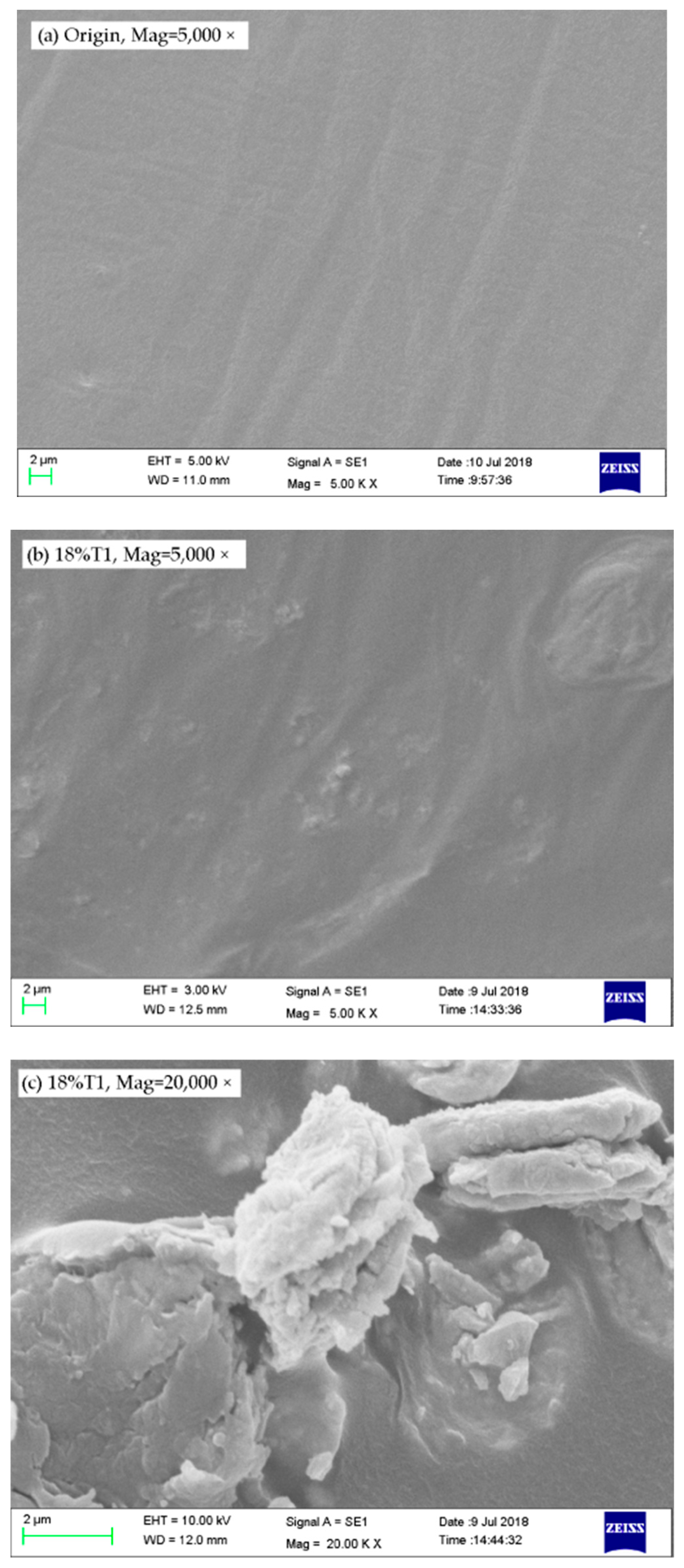
| Properties | Value | Methods |
|---|---|---|
| Penetration (25 °C, 0.1 mm) | 68.7 | ASTM D-5 |
| Softening point (°C) | 47.3 | ASTM D-36 |
| Ductility (15 °C, cm) | 150 | ASTM D-113 |
| Ductility (10 °C, cm) | 86 | ASTM D-113 |
| Viscosity (60 °C, Pa·s) | 298 | ASTM D-4402 |
| - | Content (%) | ||||||||
|---|---|---|---|---|---|---|---|---|---|
| - | SiO2 | Al2O3 | Fe2O3 | B2O3 | MgO | CaO | MnO | Na2O | FeO |
| tourmaline powder | 35.75 | 31.15 | 8.48 | 8.82 | 4.50 | 6.32 | 1.20 | 0.91 | 1.30 |
| negative ions treated | 40.02 | 31.15 | 8.48 | 10.82 | 4.50 | 0.16 | 1.20 | 0.91 | 1.30 |
© 2019 by the authors. Licensee MDPI, Basel, Switzerland. This article is an open access article distributed under the terms and conditions of the Creative Commons Attribution (CC BY) license (http://creativecommons.org/licenses/by/4.0/).
Share and Cite
Ye, Q.; Dong, W.; Wang, S.; Li, H. Research on the Rheological Characteristics and Aging Resistance of Asphalt Modified with Tourmaline. Materials 2020, 13, 69. https://doi.org/10.3390/ma13010069
Ye Q, Dong W, Wang S, Li H. Research on the Rheological Characteristics and Aging Resistance of Asphalt Modified with Tourmaline. Materials. 2020; 13(1):69. https://doi.org/10.3390/ma13010069
Chicago/Turabian StyleYe, Qunshan, Wenzhuo Dong, Shipei Wang, and Heng Li. 2020. "Research on the Rheological Characteristics and Aging Resistance of Asphalt Modified with Tourmaline" Materials 13, no. 1: 69. https://doi.org/10.3390/ma13010069
APA StyleYe, Q., Dong, W., Wang, S., & Li, H. (2020). Research on the Rheological Characteristics and Aging Resistance of Asphalt Modified with Tourmaline. Materials, 13(1), 69. https://doi.org/10.3390/ma13010069





